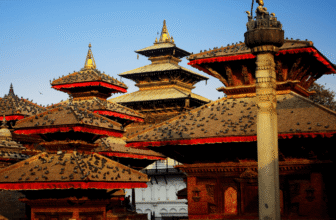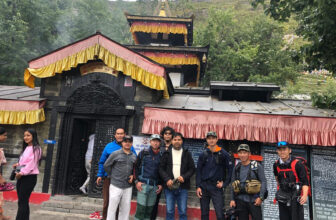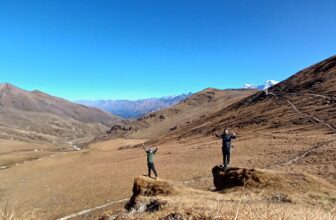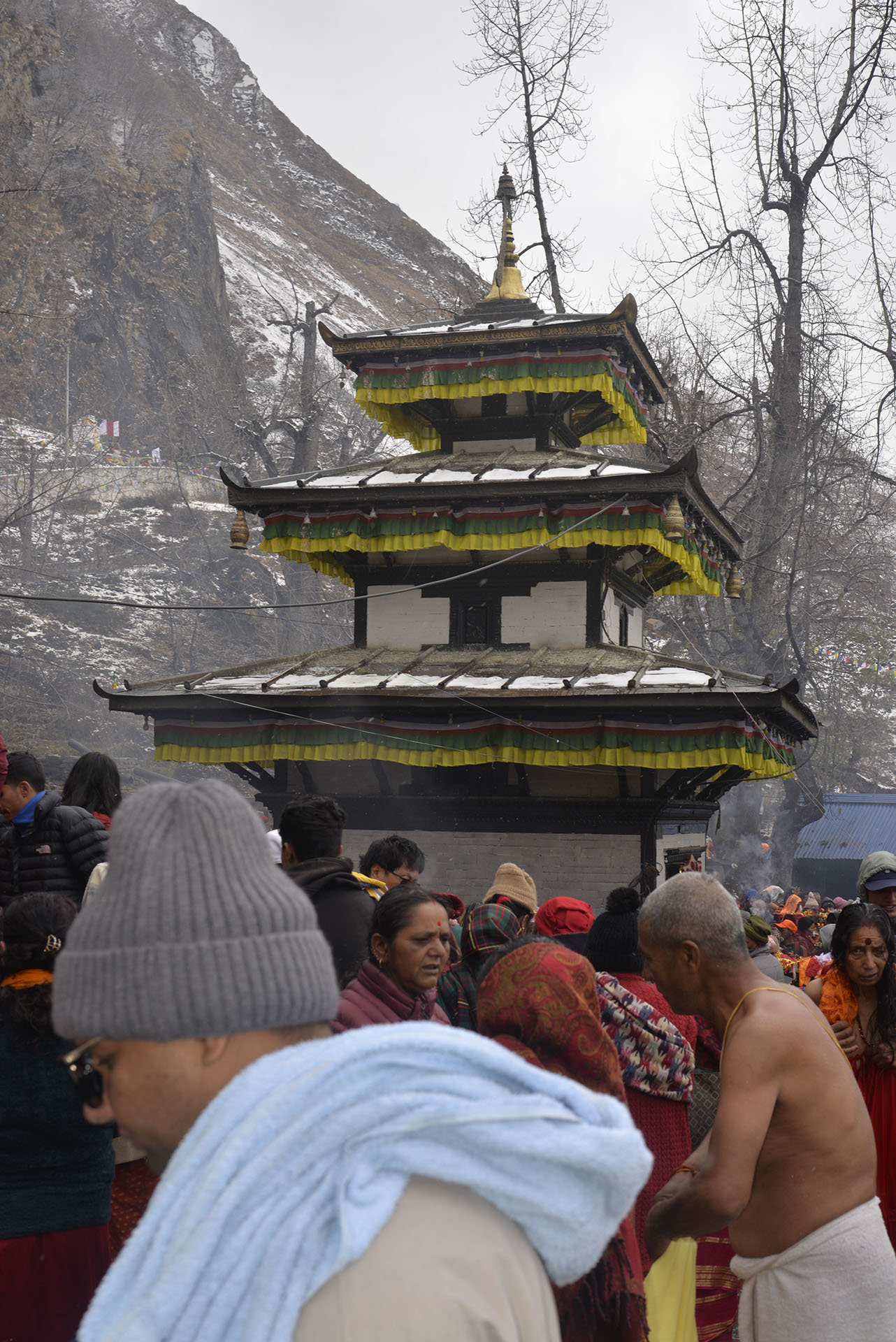
Muktinath, at 3,710 meters in Nepal’s Mustang district, is a sacred temple for both Hindus and Buddhists. Pilgrims visit to bathe under 108 holy water spouts. They see the eternal flame that has burned for centuries. They also admire stunning views of the Annapurna and Dhaulagiri ranges. You can reach Muktinath from Pokhara by jeep, flight, or helicopter. It offers a transformative experience where faith meets Himalayan beauty.
Muktinath appeals to the devout and the curious. For believers, it offers moksha — liberation from rebirth. Adventurers enjoy its snow-capped peaks, rich culture, and serene landscapes. Even non-religious visitors often feel lighter. It’s as if the mountains share something eternal.
Even if you seek blessings, or stillness, Muktinath leaves a lasting impression, not only by its peaceful and holy environment but also with breathtaking views from here.
Quick Overview of Muktinath
| Detail | Information |
| Location | Mustang District, Nepal |
| Altitude | 3,710 meters |
| Main Attractions | 108 Muktidhara spouts, Eternal Flame (Jwala Mai), Vishnu Temple |
| Best Season | March–May & September–November |
| Religious Importance | Hindu Divya Desam, Buddhist Chumig Gyatsa |
| Accessibility | Jeep, Flight, or Helicopter from Pokhara/Kathmandu |
| Languages | Nepali, Hindi, English |
Spiritual Significance – Why Muktinath is Sacred
Muktinath is more than a visit; it’s a spiritual journey.
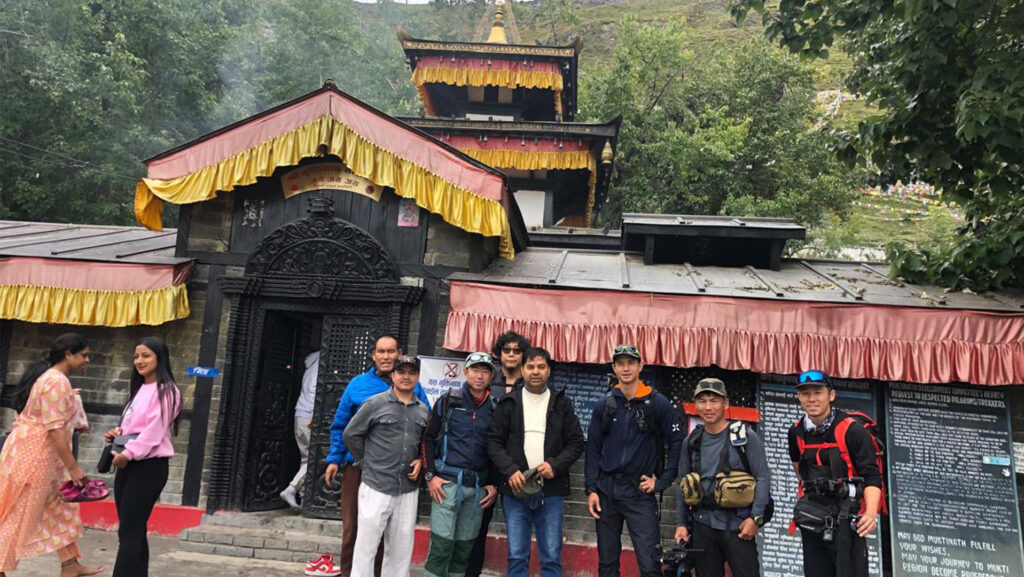
Hindu Perspective
For Hindus, Muktinath is one of the 108 Divya Desams. Devotees consider these temples sacred to Lord Vishnu. People believe that a visit brings moksha, freeing one from the cycle of rebirth. Bathing under the 108 water spouts, or Muktidhara, purifies the body and soul.
Buddhist Perspective
Buddhists call Muktinath Chumig Gyatsa, meaning “Hundred Waters.” People say that Guru Rinpoche, also known as Padmasambhava, meditated here. He blessed the land with spiritual energy. The eternal flame, Jwala Mai, burns from underground gas. It symbolizes the unity of earth, water, and fire. Many travelers leave Muktinath with a sense of calm. The crisp mountain air, flowing waters, and peaceful temple vibe bring a deep sense of inner peace. It’s not sightseeing; it’s a journey for the soul.
Natural and Cultural Appeal
Muktinath offers a profound spiritual experience and breathtaking visual beauty. The temple, nestled by the Himalayas, provides stunning views of Annapurna and Dhaulagiri. Snowy peaks and blue skies make for a calm setting. This boosts the sacred feel of the place.
Mustang is rich in Tibetan culture. Visitors can see unique traditions, colorful monasteries, and ancient buildings. These reflect centuries of spiritual history. Local residents are friendly and inviting. They offer a look into a simple yet rich mountain lifestyle.
During your visit, you’ll see traditional rituals and ceremonies. This includes prayers at the temple and offerings at the sacred water spouts. These practices link travelers to the local culture. They also help deepen appreciation for the area’s spiritual importance.
Unique Experiences You Can Have Here
Visiting Muktinath offers unique experiences.
One key ritual is taking a holy bath under the 108 sacred water spouts. Pilgrims believe this cleansing purifies both the body and the soul.
Lighting a lamp at Jwala Mai, the eternal flame, is another powerful experience. Many find this act a profound experience that connects them with the temple’s sacredness.
For nature lovers, Muktinath has several trekking routes. These paths offer stunning views and let you explore Mustang’s rugged beauty.
The area has a wealth of cultural diversity. Travelers can explore nearby monasteries and villages. They can meet locals and enjoy the unique mountain lifestyle. Each activity enriches your journey. Muktinath offers a full cultural and spiritual experience.
Practical Information for Planning
Planning a trip to Muktinath is easier with the right information.
Best Time to Visit
The best months for a Muktinath pilgrimage are March to May and September to November. During these times, the weather is stable, the skies are clear, and the views are at their best. Avoid the monsoon season (June to August) because of heavy rain and slippery roads. Avoid the tough winter months—December to February. Snow can block mountain passes then.
How to Get There
Muktinath is accessible by various transport modes. You can travel by jeep along mountain roads for a scenic adventure. Helicopter flights from Pokhara or Kathmandu provide a faster, more comfortable option. These flights give amazing views of the Himalayas. The journey becomes part of the experience.
Accommodation Types
The area has many places to stay. You can choose from simple guesthouses or cozy hotels. Pilgrims can choose accommodations based on comfort, budget, and proximity to the temple.
Travel Tips
Altitude can affect many, so take it slow and stay hydrated. Warm clothing is key, even in warm months. Temperatures can experience a significant drop at high altitudes. Dress in a way that covers your body in temples and monasteries. Also, respect local customs and rituals. Avoid disturbing worshippers while you observe.
With proper planning, your visit to Muktinath can be smooth, safe, and fulfilling.
Cultural Guidelines for Respectful Visiting
Visiting Muktinath involves experiencing local culture with respect. Observing simple practices ensures that your visit is meaningful and appreciated.
Do’s
- Wear modest clothing that covers the shoulders and knees in temples and monasteries.
- Greet locals with a smile or a simple namaste.
- Take photos only with permission, especially inside temples or during ceremonies.
Don’ts
- Please take off your shoes before entering the temple. Always keep footwear out of sacred areas.
- Avoid disturbing prayer rituals or other worshippers, even out of curiosity.
- Do not litter; help keep the holy site clean and serene.
These guidelines help you connect with Muktinath’s spirit and culture. They also ensure you leave a good impression on the local community.
Frequently Asked Questions (FAQs)
Can non-Hindus or non-Buddhists visit Muktinath?
Why is Muktinath important?
How physically challenging is the visit?
What is the nearest airport?
When is the best time to visit Muktinath?
Are there accommodations near the temple?
Do I need special permits to visit?
Can I take photos inside the temple?
How long does a typical visit last?
Are local guides available?
Book Your Journey to Muktinath Today
Muktinath is more than a destination; it is a journey of the soul. The 108 holy water spouts and the eternal flame bring spiritual energy. The stunning Himalayan views and Tibetan culture add to the experience. Every moment here brings peace and inspiration. It deepens your connection to nature and tradition.
Muktinath offers spiritual purification, cultural insight, and mountain serenity. I will impress you. If this sacred place moves you, think about visiting from March to May or September to November. During these months, the weather is perfect, and the mountains look their best.
This is more than a trip. It’s an experience that lingers long after you return. You’ll carry memories of peace, devotion, and the unique magic of Nepal’s high Himalayas.
Book your Muktinath Darshan Tour today with Debyani Tours and Travels. Enjoy licensed guides, all permits included, and professional altitude support. Experience a safe and transformative journey.



